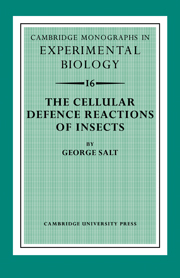Book contents
- Frontmatter
- Contents
- Acknowledgements
- 1 INTRODUCTION
- 2 PHAGOCYTOSIS
- 3 ENCAPSULATION
- 4 NODULE FORMATION
- 5 OBJECTS THAT EXCITE CELLULAR REACTIONS
- 6 THE REACTIONS OF INSECT BLOOD CELLS
- 7 CELLULAR REACTIONS AND IMMUNITY
- 8 A COMPARISON OF INSECT AND VERTEBRATE DEFENCE REACTIONS
- References
- Index of organisms
- Index of subjects
- Plate section
6 - THE REACTIONS OF INSECT BLOOD CELLS
Published online by Cambridge University Press: 20 April 2010
- Frontmatter
- Contents
- Acknowledgements
- 1 INTRODUCTION
- 2 PHAGOCYTOSIS
- 3 ENCAPSULATION
- 4 NODULE FORMATION
- 5 OBJECTS THAT EXCITE CELLULAR REACTIONS
- 6 THE REACTIONS OF INSECT BLOOD CELLS
- 7 CELLULAR REACTIONS AND IMMUNITY
- 8 A COMPARISON OF INSECT AND VERTEBRATE DEFENCE REACTIONS
- References
- Index of organisms
- Index of subjects
- Plate section
Summary
The cellular defence reactions of insects derive ultimately from the behaviour of individual blood cells. In part those cells act separately, as in phagocytosis and in the initial reaction to a foreign body. In part they act together, as in encapsulation; and when they do so, the behaviour of each may be affected by the concerted activity of all. An attempt will now be made to analyse cellular defence reactions, with a view to exposing the succession of stimuli received and responses made by the blood cells as a reaction takes its course.
It is impossible in a small book to deal with the variant reactions of different species to different objects. In order to avoid continual qualification, the analysis that follows is largely restricted to cellular capsules, and is based principally on reactions observed in caterpillars of Ephestia.
To begin with, it will be convenient to distinguish six successive phases of reaction. The first is that of contact between a blood cell and the foreign body, and the problem is to learn how that contact is brought about. The next phase is the adhesion of the two; it calls for consideration of the stimuli that cause blood cells to adhere to most surfaces but not to all. Reaction to a large foreign body involves the cohesion of cells which have no direct contact with the foreign surface, and it also involves the aggregation of a large number of cells; so that we need to understand how those cells come together so quickly and what makes them cohere.
- Type
- Chapter
- Information
- The Cellular Defence Reactions of Insects , pp. 68 - 84Publisher: Cambridge University PressPrint publication year: 1970
- 1
- Cited by



